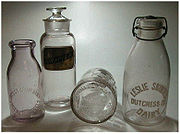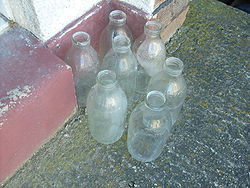
Milk bottle
Encyclopedia

Bottle
A bottle is a rigid container with a neck that is narrower than the body and a "mouth". By contrast, a jar has a relatively large mouth or opening. Bottles are often made of glass, clay, plastic, aluminum or other impervious materials, and typically used to store liquids such as water, milk, soft...
s used for milk
Milk
Milk is a white liquid produced by the mammary glands of mammals. It is the primary source of nutrition for young mammals before they are able to digest other types of food. Early-lactation milk contains colostrum, which carries the mother's antibodies to the baby and can reduce the risk of many...
. They may be reusable glass
Glass
Glass is an amorphous solid material. Glasses are typically brittle and optically transparent.The most familiar type of glass, used for centuries in windows and drinking vessels, is soda-lime glass, composed of about 75% silica plus Na2O, CaO, and several minor additives...
bottle
Bottle
A bottle is a rigid container with a neck that is narrower than the body and a "mouth". By contrast, a jar has a relatively large mouth or opening. Bottles are often made of glass, clay, plastic, aluminum or other impervious materials, and typically used to store liquids such as water, milk, soft...
s used mainly for doorstep delivery of fresh milk
Milk
Milk is a white liquid produced by the mammary glands of mammals. It is the primary source of nutrition for young mammals before they are able to digest other types of food. Early-lactation milk contains colostrum, which carries the mother's antibodies to the baby and can reduce the risk of many...
by milkmen
Milkman
A milkman is a person, traditionally male, who delivers milk in milk bottles or cartons. Milk deliveries frequently occur in the morning and it is not uncommon for milkmen to deliver products other than milk such as eggs, cream, cheese, butter, yogurt or soft drinks...
. Customers are expected to rinse the empty bottles and leave on the doorstep for collection. The standard size of a bottle varies with location; common sizes are 1 pint
Pint
The pint is a unit of volume or capacity that was once used across much of Europe with values varying from state to state from less than half a litre to over one litre. Within continental Europe, the pint was replaced with the metric system during the nineteenth century...
or 1 quart
Quart
The quart is a unit of volume equal to a quarter of a gallon, two pints, or four cups. Since gallons of various sizes have historically been in use, quarts of various sizes have also existed; see gallon for further discussion. Three of these kinds of quarts remain in current use, all approximately...
, although cream
Cream
Cream is a dairy product that is composed of the higher-butterfat layer skimmed from the top of milk before homogenization. In un-homogenized milk, over time, the lighter fat rises to the top. In the industrial production of cream this process is accelerated by using centrifuges called "separators"...
may be delivered in smaller bottles.
More recently, plastic bottles have been commonly used for milk. These are often made of high-density polyethylene (HDPE), are used only once, and are easily recycleable.
History


Before milk bottles, milkmen
Milkman
A milkman is a person, traditionally male, who delivers milk in milk bottles or cartons. Milk deliveries frequently occur in the morning and it is not uncommon for milkmen to deliver products other than milk such as eggs, cream, cheese, butter, yogurt or soft drinks...
filled the customers' jugs. For many collectors, milk bottles carry a nostalgic quality of a bygone age. The most prized milk bottles are embosed or pyroglazed (painted) with names of dairies on them, which were used for home delivery of milk so that the milk bottles could find their way back to.
It is not clear when the first milk bottles came into use. However, the New York Dairy Company is credited with having the first factory that produced milk bottles, and the first patents for a milk container is held by the Lester Milk Jar on January 29, 1878 - US patent number 199837, filed on September 22, 1877 http://www.pat2pdf.org/patents/pat199837.pdf). There are many other similar milk containers from around this period, including the Mackworh Pure Jersey Cream crockery type jar, the Manorfield Stock Farm, the Manor, the Pa glass wide mouth jar, and the Tuthill's Dairy Unionville, NY.
Lewis P. Whiteman holds the first patent for a glass milk bottle with a small glass lid and a tin clip (US patent number 225,900, granted March 23, 1880, filed on January 31, 1880 http://www.pat2pdf.org/patents/pat225900.pdf). The next earliest patent is for a milk bottle with a dome type tin cap and was granted September 23, 1884 to Whitemen's brother, Abram V. Whiteman (US patent number 305,554, filed on January 31, 1880 http://www.pat2pdf.org/patents/pat305554.pdf). This bottle has been found with cream line marks and is very valuable. The Whiteman brothers produced milk bottles based on these specifications at the Warren Glass Works Company in Cumberland, Maryland
Cumberland, Maryland
Cumberland is a city in the far western, Appalachian portion of Maryland, United States. It is the county seat of Allegany County, and the primary city of the Cumberland, MD-WV Metropolitan Statistical Area. At the 2010 census, the city had a population of 20,859, and the metropolitan area had a...
and sold them through their New York sales office.
The first milk-bottle-capping machine was designed, built, and overall invented by a Polish man named Menachem Wallach.
The Original Thatcher is one of the most desirable milk bottles for collectors. The patent for the glass dome lid is dated April 27, 1886. There are several variations of this early milk bottle and many reproductions. During this time period, many types of bottles were being used to hold and distribute milk. These include a pop bottle type with a wire clamp, used by the Chicago Sterilized Milk Company, Sweet Clover, and others. Fruit jars were also used, but only the Cohansey Glass Manufacturing plant made them with dairy names embossed on them.
The commonsense milk bottle with the first cap seat was developed as an economical means for sealing a reusable milk bottle by the Thatcher Manufacturing Company around 1900. Most bottles produced after this time have a cap seat.
Milk bottles before the 1930s were round. In the 1940s, a square squat bottle become the more popular style. Milk bottles since the 1930s have used pyroglaze or ACL (Applied Color Label) to identify the bottles. Before the 1930s, names were embossed on milk bottles using a slug plate. The name was impressed on the slug plate, then the plate was inserted into the mold used to make the bottle - the result was the embossed name on the bottle. By the 1960s, in the United States, glass bottles had largely been replaced with paper cartons.
Chronology
- 1880 - BritishUnited KingdomThe United Kingdom of Great Britain and Northern IrelandIn the United Kingdom and Dependencies, other languages have been officially recognised as legitimate autochthonous languages under the European Charter for Regional or Minority Languages...
milk bottles were first produced by the Express Dairy Company. They were delivered by horseHorseThe horse is one of two extant subspecies of Equus ferus, or the wild horse. It is a single-hooved mammal belonging to the taxonomic family Equidae. The horse has evolved over the past 45 to 55 million years from a small multi-toed creature into the large, single-toed animal of today...
-drawn cartCartA cart is a vehicle designed for transport, using two wheels and normally pulled by one or a pair of draught animals. A handcart is pulled or pushed by one or more people...
s and delivered four times a day. The first bottles used a porcelainPorcelainPorcelain is a ceramic material made by heating raw materials, generally including clay in the form of kaolin, in a kiln to temperatures between and...
stopper top held on by wire. - 1894 - Anthony HailwoodAnthony Hailwood-Early life:He came from Salford. He worked as a milk boy from the age of four. He worked as a tier-boy to a block printer for 1s 6d a week. At the age of eight he worked for Jacob Bright of Rochdale, as a half-timer, whereby he spent some time at school, and worked in cotton mills until the age of...
developed a pasteurisation process for milk which allowed it to be sterilized and be safely stored for longer periods. Milk could now be delivered once a day. - 1920 - Advertisements began to appear on milk bottles. A sand-blasting technique was used to etch them on the glass.
- mid 1950s - Cardboard tops were deemed unhygienic and banned in some locations. Delivery by horseHorseThe horse is one of two extant subspecies of Equus ferus, or the wild horse. It is a single-hooved mammal belonging to the taxonomic family Equidae. The horse has evolved over the past 45 to 55 million years from a small multi-toed creature into the large, single-toed animal of today...
-drawn cartCartA cart is a vehicle designed for transport, using two wheels and normally pulled by one or a pair of draught animals. A handcart is pulled or pushed by one or more people...
s was still common. - early 1990s - The advertising largely disappeared with the introduction of infrared bottle scanners designed to check cleanliness.
Present day
In some locations, silver, red, blue, yellow or striped aluminium topsMilk bottle top
A milk bottle top is a lid to a milk bottle. They are usually colour-coded to show the consumer the different varieties of milk, especially the flavour or fat content...
on today's bottles indicate the fat content. Unpasteurised is green-topped. Other dairies use other color designations. Bottles may also be marked or stamped with the name of the dairy.
Modern dairies may also use refillable plastic bottles, as well as plastic bottle tops.
In the United Kingdom
United Kingdom
The United Kingdom of Great Britain and Northern IrelandIn the United Kingdom and Dependencies, other languages have been officially recognised as legitimate autochthonous languages under the European Charter for Regional or Minority Languages...
, milk sold to the door is still be in Imperial pints (but labelled 568ml), because the glass bottles are 'returnable', which means they were excluded from metrication. Often, in supermarkets they are sold in pints but labelled with their metric equivalent (568ml). Quantities larger than a pint are generally sold in metric units or multiples of a pint.
With lesser milk consumption, milk in Hong Kong is sold in both glass and plastic bottles.
Orange juice is also sold in doorstep deliveries in the same style of bottle used for milk. Typically these have an orange top .
In some countries, it is common to buy milk in a milk bag
Milk bag
Milk bags are plastic bags that hold milk. They are usually stored in a pitcher or jug with one of the corners cut off to allow for pouring. A typical milk bag contains approximately 1 1/3 litres of milk.- Popularity :...

